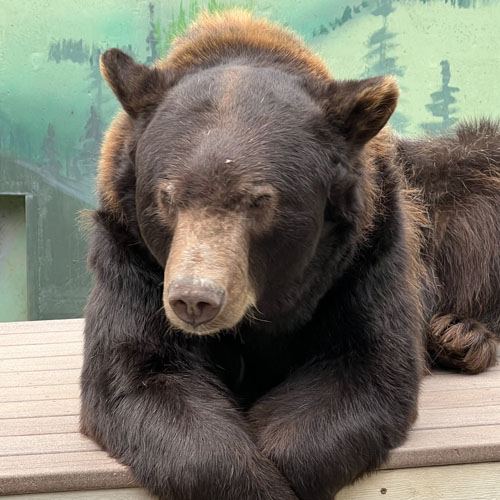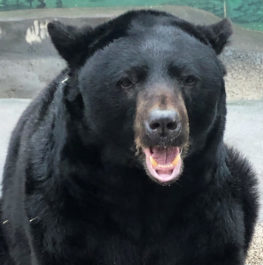Black bear cubs are cute and start out little, but grow into their full wild & dangerous selves as they mature. Our black bears were orphaned wild bear cubs that were habituated and fed by humans. For this reason they are not good candidates for release as they lack a fear of humans that would bring them into populated areas. Their hunger for human food would have labeled them as nuisance bears and they faced euthanasia if we hadn’t provided a space for them.
American Black Bear – Ursus americanus
Habitat: Forested areas of North America
Lifespan: Wild 10-20 years; Captivity 15-30 years
Diet: Omnivore
Status: Least concern
Black bears live throughout most of North America, including northern Mexico. They typically live in forests and are excellent tree climbers, even sleeping in trees during the summer. They’re also found in mountains and swamps. Despite their name, black bears can be blue-gray or blue-black, brown, cinnamon, or even sometimes (rarely) white.
In addition to eating berries, roots, and salmon, black bears also prey on deer, moose, insects, and sometimes even carrion (dead animal flesh left behind by other predators). They’re not picky eaters since their goal is to store up as much body fat as possible before their winter hibernation.
In late November and early December, black bears head to their dens to sleep away the winter or hibernate. Their body temperature and heart rate are lowered, and their breathing slows down while they live off the huge amounts of body fat they stored up during the summer and fall. This way, they don’t have to leave their dens and hunt for food in the bitter cold.
Male black bears leave their dens around mid-March, but females stay a little longer. That is because they give birth around January and want to give their cubs time to nurse and grow bigger before heading back outside in the early spring. Black bear cubs stay with Mom for one to three years while she teaches them how to live in the wild. Then, when they are ready, they head off to survive in the woods alone—until they start a family of their own.
Black bears are smaller than brown bears, often called grizzlies. Black bear cubs weigh less than one pound at birth. They gain 20 to 30 pounds in three months. Excellent swimmers, black bears can paddle at least a mile and a half in freshwater. A bear’s claws can grow as long as a whiteboard eraser.
Meet Our Black Bears

Oscar
Oscar is a black bear, although his coat is brown. Despite their name, black bears can vary in color from black to brown, cinnamon and even what is known as glacier blue and appears silver. Oscar was reported to Fish and Wildlife as a young cub when he was spotted rummaging through some trash bins outside an abandoned garage. After some research it was found that he had been abandoned and at his age would not make it in the wild. Too young for successful rehabilitation, Oscar was brought to Cat Tales at less than a year old and today is often seen enjoying a swim or munching on some fresh fruit, his favorite snack! Born February 2003

Oso
aka Oso-much-troubleOso, meaning bear in Spanish, was given his name for being O-so much trouble! Quite the rambunctious cub, Oso came to us from a private owner at just over a year old, weighing bear-ly twenty lbs. Oso was being kept illegally and housed in a bathtub. An obviously bad environment for the bear, he suffered from a lack of proper nutrition, which is what caused him to be so underweight when rescued. Since his rough start in life, he was brought to Cat Tales to stabilize but was too dependent on humans to go to the wild. To this day Oso possesses a VERY healthy appetite due to his early years dealing with malnourishment. Born February 2004


